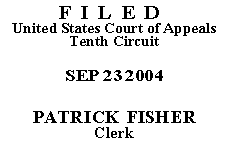

| KATHLEEN CAUSEY,
Plaintiff-Appellant, v. JO ANNE B. BARNHART, Commissioner, Social Security Administration, Defendant-Appellee. |
|
Plaintiff-appellant Kathleen Causey appeals from an order of the district court affirming the Social Security Administration's decision denying her application for supplemental security income benefits. We exercise jurisdiction under 42 U.S.C. § 405(g) and 28 U.S.C. § 1291 and affirm.
Plaintiff claims that she has been unable to work since June 28, 1993, due to chronic obstructive pulmonary disease or asthma, multiple sclerosis, hypertension, and body pain. After her application was denied initially and on reconsideration, a de novo hearing was held before an administrative law judge (ALJ). Subsequently, in a decision dated May 16, 2001, the ALJ denied plaintiff's application for disability benefits, concluding that plaintiff was not disabled. The ALJ determined that plaintiff suffered from severe impairments which prevented her from performing her past relevant light work as a housekeeper and office cleaner. However, she retained the residual functional capacity (RFC) to perform a wide range of sedentary work, and based on the testimony of the vocational expert at the hearing before the ALJ, she was capable of performing other jobs that existed in significant numbers in the national economy.
The Appeals Council denied review, making the ALJ's decision the Commissioner's final decision. See Doyal v. Barnhart, 331 F.3d 758, 759 (10th Cir. 2003). Plaintiff then filed a complaint in the district court, which entered an order affirming the ALJ's decision. This appeal followed.
In reviewing the ALJ's decision, "we neither reweigh the evidence nor substitute our judgment for that of the agency." Casias v. Sec'y of Health & Human Servs., 933 F.2d 799, 800 (10th Cir. 1991). Instead, we review the ALJ's decision only to determine whether the correct legal standards were applied and whether the ALJ's factual findings are supported by substantial evidence in the record. Doyal, 331 F.3d at 760.
Plaintiff raises one narrow issue: whether the ALJ failed to give appropriate consideration to one aspect of her treating physician's opinion, so we confine our analysis of this case to a resolution of this specific issue. "In deciding how much weight to give a treating source opinion, an ALJ must first determine whether the opinion qualifies for 'controlling weight.'" Watkins v. Barnhart, 350 F.3d 1297, 1300 (10th Cir. 2003). An ALJ is required to give the opinion of a treating physician controlling weight when it is both: (1) "well-supported by medically acceptable clinical and laboratory diagnostic techniques;" and (2) "consistent with other substantial evidence in the record." Id. (quotation omitted). "[I]f the opinion is deficient in either of these respects, then it is not entitled to controlling weight." Id.
Even if a treating physician's opinion is not entitled to controlling weight, it is "still entitled to deference and must be weighed" using the following factors:
(1) the length of the treatment relationship and the frequency of examination; (2) the nature and extent of the treatment relationship, including the treatment provided and the kind of examination or testing performed; (3) the degree to which the physician's opinion is supported by relevant evidence; (4) consistency between the opinion and the record as a whole; (5) whether or not the physician is a specialist in the area upon which an opinion is rendered; and (6) other factors brought to the ALJ's attention which tend to support or contradict the opinion.
Id. at 1301 (quotations omitted). After considering these factors, "the ALJ must give good reasons in [his] . . . decision for the weight he ultimately assigns the opinion." Id. (quotation omitted).
Here, plaintiff's treating physician, Dr. Waldrop, provided a medical source statement form evaluating plaintiff's ability to lift, stand, walk, sit, and push or pull. The form also reflected Dr. Waldrop's check-mark agreement to a statement that plaintiff was "required to lie down during the normal workday to manage pain." Aplt. App., Tab 3 at 276, ¶ 2(A)(7). Dr. Waldrop, however, did not follow the form's instruction to "[b]riefly describe the principal, clinical and laboratory findings and symptoms or allegations (including pain) from which [the described] impairment-related capacit[y] and limitation[]" was derived. Id. at ¶ 2(E). The ALJ adopted all of the restrictions listed by Dr. Waldrop except for plaintiff's need to lie down. With regard to that "extreme limitation," the ALJ stated that Dr. Waldrop "was unable to provide any substantiating documentation." Id. at 18.
Implicit in the ALJ's decision is a finding that Dr. Waldrop's opinion on plaintiff's need to lie down during the normal workday is not entitled to controlling weight. Further, the ALJ considered the Watkins factors in his decision, albeit in an abbreviated and scattered fashion. He noted that claimant had "been under the care of [Dr.] Waldrop for many years." Id. at 17. He also evaluated the medical record, primarily compiled by Dr. Waldrop, and the credibility of plaintiff's testimony on her subjective claims. Id. at 17-18. With this background, the ALJ determined that the record did not support the claimed need for plaintiff to lie down during the workday. Id. at 17.
The ALJ could have been more meticulous in following the established Tenth Circuit framework for evaluating a treating physician's opinion. However, his decision provides legally sufficient and factually supported reasons for rejecting this one aspect of Dr. Waldrop's opinion. Our careful review of the record on appeal, in light of the deferential appellate standard, leads us to AFFIRM the judgment of the district court.
Entered for the Court
Circuit Judge
*. This order and judgment is not binding precedent, except under the doctrines of law of the case, res judicata, and collateral estoppel. The court generally disfavors the citation of orders and judgments; nevertheless, an order and judgment may be cited under the terms and conditions of 10th Cir. R. 36.3.